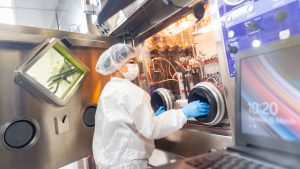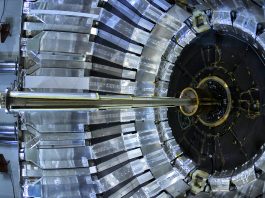TRIUMF, Canada’s particle accelerator centre, is putting Canada on the Big Science global stage.
The 20th century had some of humankind’s most significant scientific achievements. From the mass-produced automobile to the space race and beyond, we continually sought ever-higher mountains to climb.
In an article published in Science in 1961, Oak Ridge National Laboratory Director Alvin M Weinberg wrote: “When history looks at the 20th century, she will see science and technology as its theme; she will find in the monuments of Big Science – the huge rockets, the high-energy accelerators, the high-flux research reactors – symbols of our time just as surely as she finds in Notre Dame a symbol of the Middle Ages.”
Weinberg’s assertion about these ‘monuments’ was, of course, prescient – 60 years later (and well into the 21st century), many of our greatest and most definitive scientific monuments have emerged from experimental physics, nuclear power generation, and space travel. But perhaps more prescient was the coining of ‘Big Science’ as the singular term to describe what has become the world’s largest, most complex, and most collaborative scientific endeavours. Today, Big Science speaks to the magnitude of the apparatus required to drive discovery and innovation; to do excellent science, we need big communities, big laboratories, big machines, and big budgets.
Such a simple phrase belies the inherent complexity and unity that large-scale research requires, which is the very nature of how we now do science. No longer does the march of progress rely so manifestly on single-point geniuses – the Einsteins, Newtons, or Curies – making ground-breaking discoveries in isolation or within the confines of the ivory tower. Today, international research teams work across borders to tackle scientific inquiries at a scale and scope that would have been unimaginable to our science forebears. Much of the large-scale science performed today requires thousands-strong teams of top talent in the traditional areas of physics, chemistry, and biology and the requisite research and development support areas like engineering, technological support, and administration.
Unsurprisingly, this co-ordinated and collaborative approach has allowed us to perform better science and expand our understanding of our universe and ourselves in unprecedented ways. Among other achievements, Big Science has brought us the discovery of the Higgs boson, the elusive and long-theorised particle that confers mass to matter; the ability to map the entire human genome for the first time; and, through co-ordinated, multi-messenger arrays of telescopes, increasingly profound glimpses into the darkest abysses of the Universe, deeper than was ever thought possible.
Canada’s Big Science ambitions
Despite a historically natural resource-focused economy and a relatively small population, Canada has developed a strong reputation as a global leader in some of the world’s most important large-scale Big Science endeavours. This is in part due to its intentional positioning as an accessible, globally engaged convener and peacemaker, coupled with concerted post-war science funding that seeded a program of national infrastructure development and support for academic institutions. Canada has produced a variety of Nobel laureates in physics, chemistry, and medicine, and retains a high rank in scientific research quality among international scientists. The nation’s science output is supported by a strong base of colleges and universities, many of which consistently rank among the best in the world. Canada’s science leadership is also evident in its major research facilities, which include the deep underground mine SNOLAB, the Canadian Light Source, and the Vancouver-based TRIUMF, Canada’s particle accelerator centre.
TRIUMF is one of a handful of subatomic research facilities in the world capable of producing extremely intense beams of rare isotopes; due to both its facilities and the community of particle accelerator experts it convenes today, the Vancouver-based laboratory has become an international hub for scientists and students working in fields like nuclear astrophysics (which sees researchers using rare isotope beams to study the origin and processes of element formation in stellar events) to life sciences (and the production of critical medical isotopes for diagnosing and treating disease) to materials sciences (where beams are useful for characterising materials like superconductors, or designing and testing next-generation batteries) and beyond.

©TRIUMF
In the spirit of Big Science, collaboration and community are at TRIUMF’s core. Unlike its federally operated sister laboratories in the United States, TRIUMF was first envisioned as a joint endeavour between a trio of local universities (the University of British Columbia, Simon Fraser University, and the University of Victoria) before the organisation’s first board meeting in 1968, a fourth institution (the University of Alberta) had signed on, with many others eagerly joining shortly after. Today, the lab is owned and operated by a consortium of 21 member universities nationwide – a big community! – all of which contribute equally to the laboratory’s mission and science programs.
And though it’s not as big as the Large Hadron Collider, TRIUMF’s 520 MeV cyclotron is the largest of its kind in the world at 18 metres in diameter, and 4,000 tonnes in mass, and its associated laboratories have come to comprise one of the single largest investments of Canadian science infrastructure in the nation’s history. Empowered by these unique facilities, TRIUMF has established a strong track record of scientific excellence, leading important investigations into the nature of matter, advancing a thriving ecosystem for accelerator-produced medical isotopes, and training tens of thousands of students, scientists and STEM leaders across more than five decades.
As Canada’s largest university-owned research facility, TRIUMF continues to amplify the impact of Canadian science on the world stage by thinking globally and working collaboratively. For example, through TRIUMF, Canadians have played leading roles in building, installing, and operating the ATLAS detector, one of the two main detectors at the Large Hadron Collider that provided our first glimpse at the Higgs Boson and garnered the 2012 Nobel Prize in Physics. Similarly, the lab enables Canadian expertise in physics, accelerator development, and detector technologies to flow out to experiments and facilities, including through collaborations and agreements that support Hyper-K in Japan, VECC in India, the Electron-Ion Collider (EIC) in the US, and more. TRIUMF’s Center for Molecular and Materials Science provides globally sought-after capabilities for probing the properties of materials and chemical systems using beams of muons (muon spin rotation, relaxation, and resonance, or muSR). Through TRIUMF, the world’s subatomic physics and innovation communities can access Canadian talent, infrastructure, and innovation.
The future face of particle accelerator-based research in Canada: ARIEL and IAMI
Within the confines of the laboratory’s 13-acre site, TRIUMF’s community of researchers, engineers, and designers are now augmenting the lab’s 50-year-old beamlines (which are still prolific in exploring fundamental physics, delivering cutting-edge medical isotopes, and more) with new accelerator technologies and downstream radioisotope production facilities that will only serve to expand TRIUMF as a big laboratory and broaden the impact of its role in international science.
At TRIUMF’s Advanced Rare Isotope Laboratory (ARIEL), a flagship multidisciplinary research facility, an enhanced accelerator apparatus will deliver unprecedented intensities of rare isotope beams, allowing for multiple experiments to be conducted simultaneously with a diverse library of isotopes. A new superconducting electron linear accelerator (the most powerful e-linac for online production of isotopes worldwide) and two additional target stations will soon triple the lab’s output of rare isotopes. Using these new beams, researchers will be able to open new avenues for investigation using TRIUMF’s existing infrastructure and experimental apparatus.
Complementing this is TRIUMF’s new radiopharmacy facility, the Institute for Advanced Medical Isotopes (IAMI). IAMI is equipped with one of the world’s most technologically advanced medical cyclotrons available (a TR-24 MeV, manufactured by renowned TRIUMF spin-off company-turned-collaborator Advanced Cyclotron Systems Inc.) and a suite of Good Manufacturing Practices (GMP)-compliant laboratories that will enable TRIUMF to not only fortify the local and national supply of critically-needed diagnostic isotopes but also convene research and industry partners to investigate new, leading-edge radiopharmaceuticals and the development of radiopharmaceuticals for Canadian-based and international applications. One such isotope, actinium-225 (dubbed the Rarest Drug on Earth), has already shown overwhelmingly positive outcomes in clinical trials and is now being produced at isotope production facilities within TRIUMF.
The twinned impact of TRIUMF’s future-facing facilities and its historical focus on collaboration and global engagement are clear for Canada. TRIUMF’s particle and nuclear physics programmes are renowned; its accelerator expertise is requested for various major global collaborations, and its life sciences programme is at the cutting edge of next-generation radiopharmaceutical development. Through industry collaborations, TRIUMF supplies nearly two million patient doses of medical isotopes per year and ships them worldwide, creates spin-off companies, licences intellectual property, and boasts highly oversubscribed on-site material testing, using particle beams.
Vancouver’s clean-tech ecosystem, including nuclear power start-ups like General Fusion has significantly benefited from accessing TRIUMF infrastructure, network, and expertise for characterisation and systems development support. And, in 2020, at the onset of the COVID-19 pandemic, TRIUMF leveraged expertise in device engineering and gas handling and exchange systems (expertise gained from building dark matter experiments) to prototype, test, and enable the production of a novel, made-in-Canada ventilator for COVID patients.
Through TRIUMF – in partnership with various national research entities like the Canadian Light Source, SNOLAB, and others – Canadian research and innovation continues to be catapulted to the global stage. In 2024, Canada will gain access to Horizon Europe, a multibillion-dollar funding initiative that connects research and industry partners within and without the European Union. The agreement reflects the strong positive perspective on Canadian science within global science institutions and opens new pathways for Canadian researchers to access international funding sources.
Supercharging Canada’s science – for now and for the future
Through these large-scale research facilities, Canada has contributed world-leading, made-in-Canada scientific research to the global ecosystem. To supercharge Canadian science and maximise the nation’s contributions to critical endeavours like climate change response, clean energy, and quantum computing, the Canadian government will need to ensure appropriate mechanisms are in place to support large-scale research platforms, a key component of the research ecosystem. Without a thoughtful reconfiguration of how we fund Canadian science and significant research facilities like TRIUMF, Canada may imperil its leadership and contributions within global Big Science.
Funded appropriately, Canada’s research community and the national science infrastructure on which Canadian and global researchers rely will be able to continue supporting the country’s status as a partner of choice in research and innovation. Ensuring these elements remain strong, robust, and connected through consistent access to resources will be essential to Canada’s continued leadership in global Big Science.
Please note, this article will also appear in the seventeenth edition of our quarterly publication.





